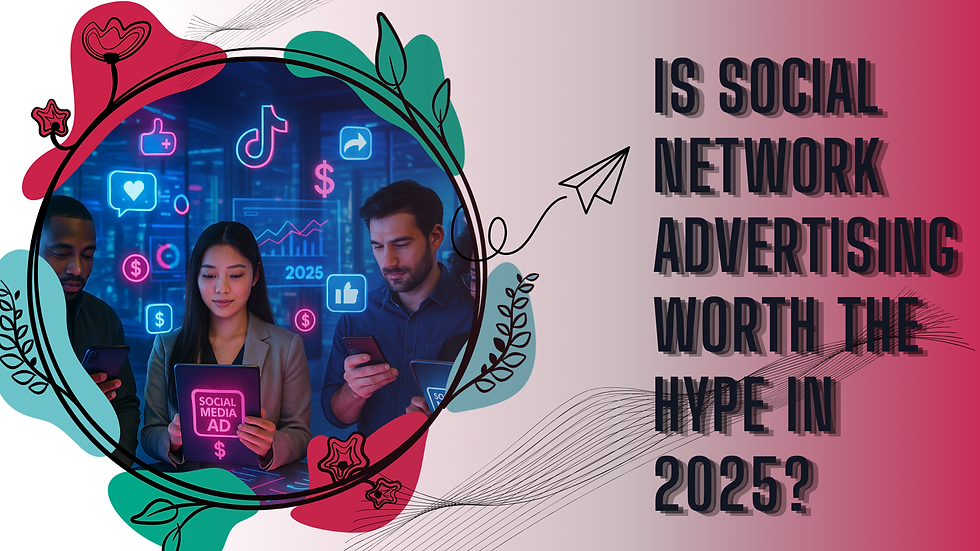Is Social Network Advertising Worth The Hype In 2025?
- hirtheardith56
- Jul 28
- 4 min read

In a digital world saturated with posts, reels, and memes, advertising has had to evolve beyond simple billboards or TV commercials. Enter social network advertising — a modern strategy that leverages platforms like Facebook, Instagram, LinkedIn, and X (formerly Twitter) to reach highly targeted audiences. But as ad fatigue rises and algorithms shift constantly, many are wondering: is this form of advertising still as effective as it claims to be?
The Rise Of Advertising In The Age Of Social Media
The last decade has witnessed a massive shift in consumer behavior. Instead of flipping through magazines or waiting for prime-time ads, people now spend hours scrolling through social feeds, interacting with friends, influencers, and yes — brands, making social network advertising a dominant force in modern marketing.
Why Brands Love Social Media?
Brands are drawn to social platforms because of their precise targeting capabilities. You can reach users based on interests, location, age, behavior, and even life events. That means a skincare brand can advertise a new anti-aging cream directly to women over 30 who follow wellness pages — all in just a few clicks.
Additionally, the visual and interactive nature of these platforms means brands can tell stories, spark conversations, and even go viral — often with lower budgets than traditional media requires.
The Pros & Pitfalls Of Social Network Campaigns
While there’s no doubt that advertising on social networks brings potential, it also comes with its own set of challenges.
What Works Well?
Social media campaigns are flexible — you can launch, pause, edit, or retarget at any time. They are ideal for A/B testing creatives, measuring click-through rates, and optimizing return on ad spend (ROAS). Small businesses especially benefit from the cost control and scalability of these platforms.
Influencer collaborations also play a major role. Micro-influencers in niche markets can bring trust and engagement that generic web advertising strategies often fail to achieve.
What To Watch Out For?
However, oversaturation is real. Users are bombarded with thousands of ads daily. With limited attention spans and ever-changing algorithms, even great campaigns can get buried. Also, rising ad costs and platform policy updates can affect consistency and reach.
So, while social advertising opens up countless opportunities, it demands continuous monitoring, testing, and strategic planning to stay effective.
Metrics That Matter: What Should You Measure?
Gone are the days of “gut feeling” marketing. Social media gives you hard numbers — if you know where to look.
Key Performance Indicators (KPIs)
CTR (Click-Through Rate): Indicates how compelling your ad is.
CPC (Cost Per Click): Tells you how efficient your spend is.
Engagement Rate: Measures how users interact with your content.
ROAS (Return on Ad Spend): The most crucial metric — how much revenue you earn compared to what you spent.
Tracking these KPIs not only helps you improve performance but also proves the ROI of your campaign to stakeholders. Tools like Meta Ads Manager, LinkedIn Campaign Manager, and third-party platforms provide detailed dashboards for real-time insights, aligning perfectly with principles of Marketing Psychology to understand and influence audience behavior effectively.
Future Of Social Network Advertising: Where Are We Headed?
With AI, personalization, and privacy regulations evolving, the future of digital advertising looks both promising and uncertain.
AI & Hyper-Personalization
Artificial Intelligence is changing the game. Algorithms now predict user behavior, automate bidding, and even generate ad creatives. This allows marketers to serve highly personalized ads that match a user’s current interests or intent — often in real time.
Privacy & Data Transparency
At the same time, data privacy laws like GDPR and iOS tracking changes are limiting advertisers’ ability to gather user data. Brands must now prioritize ethical, transparent ad practices while building first-party data strategies.
Looking ahead, social network advertising will thrive for those who adapt — blending creativity with data-driven strategy, and always keeping the user experience front and center.
You can also watch: How To Create User Request For A New Advertisement - How to Tutorial Series | PowerAdSpy
Conclusion:
In 2025, the answer isn’t a simple yes or no. Social platforms offer unmatched reach and targeting, but they also require agility, creativity, and deep analytics. Brands that embrace the evolving digital landscape, backed by authentic engagement and real value, will continue to see success. For others, it might be time to rethink the strategy.
FAQ :
Is social network advertising still effective in 2025?
Yes, it’s effective when paired with smart targeting, creative content, and real-time optimization to overcome rising costs and ad saturation.
What are the biggest challenges of social media advertising today?
Ad fatigue, rising costs, privacy rules, and frequent algorithm changes make it harder to stay visible and get strong returns without constant adaptation.
Which platforms are best for social network advertising?
Choose platforms based on audience: Facebook for reach, LinkedIn for B2B, Instagram and TikTok for engagement, Pinterest for visual and lifestyle products.



Comments